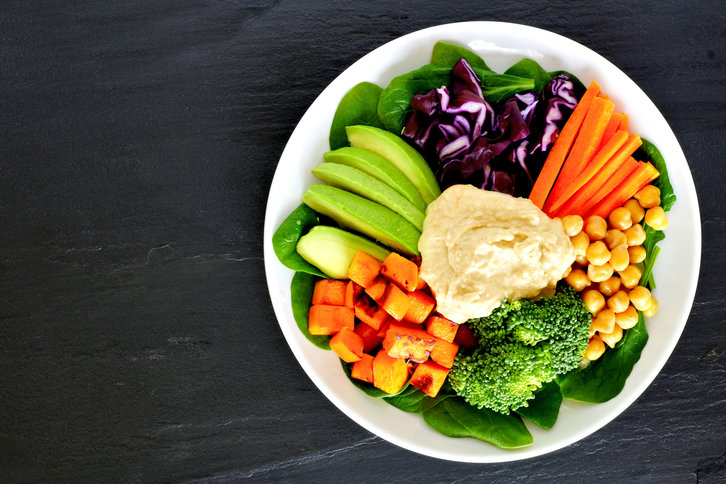
Introduction
This lesson raises learners’ awareness of some of the reasons for plant-based eating/eating less meat and helps them develop their reading and speaking skills.
In the lesson, learners first think about their own eating habits before discussing their initial thoughts and ideas related to plant-based eating and vegetarianism. Then they do a jigsaw reading task with an article about vegetarianism, with each learner reading a different section and making notes before regrouping to share what they learned. Next they plan arguments for and participate in a role play. There is also a three-part extension where they read and then create a meat-free recipe.
Lesson outcomes
- discuss the reasons for eating less meat and how they feel about this
- practise reading and note-taking skills using a text about plant-based eating
- develop speaking and use language to persuade in a role-play
- create and share a recipe without meat
Materials
- Lesson plan
- Student worksheet
- Reading text
- Presentation
- Lead-in (5 minutes)
- Show Slide 2 (Worksheet Task 1) Read the questions with the class to make sure they understand them.
- Put learners in pairs to discuss the questions.
NOTE: Don’t give feedback on answers yet and tell learners it is okay if they don’t know the answers, they will get the answer later from the reading text.
- Jigsaw reading - plant-based eating (20 minutes)
- Show Slide 3 (Worksheet Task 2a). Divide the class into four groups A, B, C and D.
- Tell students they will read one of the sections of the reading text and make notes about the main points. Give them the whole reading text folded so that only their section is visible, or cut the text into 4 sections and give them only 1.
- Show Slide 8 (Worksheet Task 2b) Now regroup the learners into groups of four, so that there is one learner who read section A, one who read section B, one who read section C, and one who read section D sitting together. Ask learners to share the main points of their section.
- Show Slide 9 (Worksheet Task 2c) Ask learners to now individually write answers to the questions in task 1, based on what their group told them. Feedback as a class.
- Show Slide 10 (Worksheet Task 2d) Ask learners to work in pairs to discuss the questions.
- Role play - eat less meat (15 minutes)
- Show Slide 11 (Worksheet Task 3). Read through the ‘Useful language for persuading’ box with the class. Elicit ways to finish the sentences, on the topic of plant-based eating, e.g. Why don’t you eat vegetarian food on Mondays? If you eat less burgers, you will save water. Drill the useful language in short phrases so the learners feel confident using them.
- Divide the class in half, student As and student Bs. As need to try to persuade their friend to eat less meat. First, As should work together in small groups to plan their arguments and let Bs work together in small groups to plan what they will say.
- Put learners into A/B pairs. Learners do the role play. Signal for them to stop when 2 minutes has passed.
- Tell learners to swap roles (A becomes B) and change partners. They now repeat the task. Remind the new As that they should try to use some phrases from the ‘Useful language for persuading’ box.
- When they have finished, ask for feedback. Who was successful in persuading their friend? Who, As or Bs, found it more difficult? Why do they think that was?
- Discuss and create - plant-based meals (15 minutes)
- Show Slide 12 (Worksheet Task 4a). Unblock any potentially unknown vocabulary from the recipe by eliciting the meanings (e.g. roasting tin- something you put in the oven), showing images (e.g. garlic cloves, coriander), or doing actions (e.g. stir, slice).
- Ask learners to work individually and order the recipe. They can compare their order with a partner before checking answers as a class.
- Check answers: b, d, a, f, c, e (Show Slide 13 if using the presentation)
- Show Slide 14 (Worksheet Task 4b). Ask learners to work in pairs to discuss the questions. Feedback as a class. Spend time on the last question about national dishes, to prepare for the next task.
Show Slide 15 (Worksheet Task 4c, d). Ask learners to work individually or in pairs. If learners have internet access they can look online to choose a recipe. BBC Good Food and the Vegetarian Society websites are good places to start:
https://www.bbcgoodfood.com/recipes/category/vegetarian
https://www.vegsoc.org/recipes/OPTIONAL:
- If learners finish in class time, ask them to present their recipe to the class or in groups. Feedback as a class, asking which recipe they want to try.
- Reflection (5minutes)
- Show learners Slide 16 (Worksheet Task 5). Put learners in pairs or small groups to discuss the questions, then feedback as a class.
- Extension tasks
As an extension/for homework learners could make a poster showing the ingredients of their recipe. If they made the recipe at home, they could also include photos and a review of the final product!